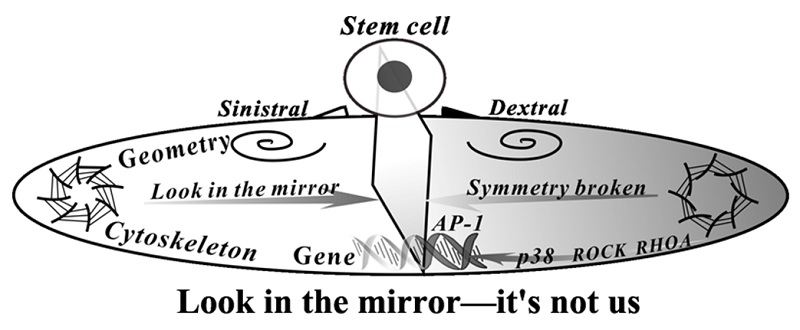Chiral geometry regulates stem cell fate, research shows
On August 26, the research team led by Prof. WANG Huiming in the Stomatology Hospital affiliated to the Zhejiang University School of Medicine published an article entitled “Chiral Geometry Regulates Stem Cell Fate and Activity” in the journal of Biomaterials. This work offers a pioneering research into the role of chiral geometry in regulating stem cell fate and activity.

Chirality is a fundamental property in nature and chiral objects are not superimposable with their mirror images. Every object, ranging from nebulae to snail shells, has its peculiar direction. The DNA double helix twists to the right whereas amino acids point out to the left. This kind of asymmetry can manifest itself in the violation of parity conservation in weak interactions at microscopic levels.
Although the origin of chirality remains unsubstantiated, it is indeed intimately bound up with our life. A prime example of this is the Thalidomide disaster in the late 1950s. Thalidomide exists in two mirror-image forms: it is a racemic mixture of (R)- and (S)-enantiomers. The (R)-enantiomer has sedative and hypnotic effects whereas the (S)-isomer is teratogenic. The Thalidomide drug with a blend of two enantiomers was a culprit behind infants born withphocomelia, or limb malformation. Therefore, researchers have attached immense importance to the rigorous separation of chiral drugs and engaged in research into the biological mechanism of chiral molecules. However, the role of geometric chirality in regulating cellular behaviors and the underlying biophysical mechanisms remain elusive.
WANG Huiming et al. reported an intriguing mechanotransduction of stem cells on chiralgeometries that human mesenchymal stem cells (hMSCs) prefer to migrate towards dextral geometry nearly 30% faster in terms of migration speed, referred to as “chirotaxis”. They also found that cell adhesion, proliferation, and differentiation of hMSCs are tremendously enhanced for cells cultured on dextral geometry than those on sinistral geometry, by triggering ranscriptionfactor AP-1 complex through p38/MAPK signaling that regulates hMSCs fate and activity. They demonstrated that the cytoskeletal network consisting of transverse and radial stress fibers exhibits a strengthening/offsetting effect on dextral/sinistral geometry through focal adhesion sites, and consequently, the cell’s cytoskeletal contractility on the dextral geometry is nearly 80% higher.

Schematic illustration and speculative pathway for symmetry breaking in stem cell fate on chiral geometry
These findings highlight the importance of geometric chirality as an extracellular cue in regulating the stem cell’s behavior through cell-material interactions. This study is also of substantial interest to the future developmentof biomaterials with enantiomorphic chiral geometry for controllinga variety of cellular behaviors.